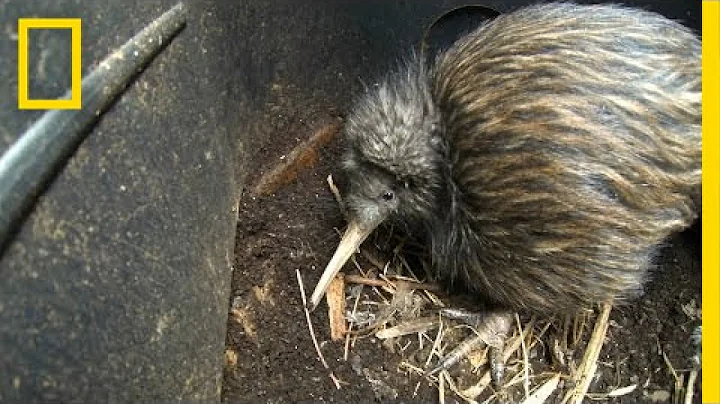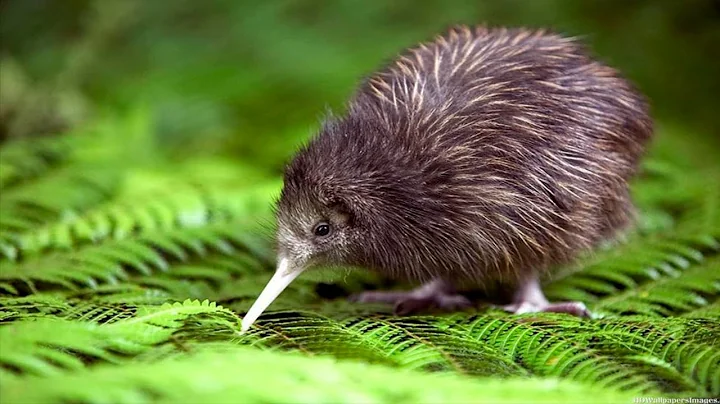's several dimensions can be said to have taken the flightless feature to the extreme. Their wings are small, vestigial, and hidden under body feathers. From the outside, the tail has completely disappeared. They are also unusual in other ways. For example, the female bird can lay eggs that can reach 1/4 of her own body weight. Unlike most other birds, kiwis rely on smell rather than sight to find food.

Hen-sized burrowers
Form and function
The body size of several dimensions is similar to that of a domestic hen, but the body is more slender and the legs are thicker and more powerful. The beak is long and curved, with a hole at the tip to allow air circulation and is used to search for food on the ground. Other birds have sternums for flight muscles, but kiwi do not. While most other birds have hollow bones to reduce weight during flight, the kiwi is only partially hollow. Although as a nocturnal animal, kiwi's eyes are relatively small, but their eyesight is good enough to ensure that they can move quickly through the lower shrubs.

Compared with the similarly flightless relatives emu, ostrich, rhea, the kiwi is very small and probably evolved only in an environment without mammals. The New Zealand Islands were formed 80 million to 100 million years ago. Kiwis evolved before adaptable land mammals; when the latter emerged, a sea barrier prevented them from landing New Zealand , thus protecting kiwis from the Competition and predation. In addition, there are other flightless birds (such as moa ) that also evolved in New Zealand, but they are now extinct.
Kiwis can detect food through their sense of smell. They use their beaks to search through the forest leaf litter or dig deep into the soil, grabbing food with the tip of their beaks, then jerking it back and swallowing it down their throats. Various species of kiwi mainly feed on invertebrates living in the soil and leaf litter, especially earthworms and beetle larvae. They also eat some plant foods, such as fruits.

Nocturnal and Diurnal
Reproduction Biology
The territory of a pair of several-dimensional mates is 20 to 100 hectares. They occupy many dens, bunkers and caves in this area. They hide in those places to rest during the day and come out to feed at night. Their nests are built in burrows or shelters under dense vegetation, with little lining. Although there are only one or two eggs in a clutch, they are the culmination of the female bird's devotion. The rich nutrients in the egg can not only maintain the growth and development of the embryo during the long incubation period (65-90 days), but also prepare a yolk sac for the newly hatched chicks as a temporary food supply source. After the eggs are laid, they rest for several days. Once the eggs begin to be hatched, for the brown and spotted kiwi, it is the male's responsibility; while for the large spotted kiwi, both partners incubate the eggs. However, it is quite doubtful whether the parent bird is responsible for raising the chicks, because the chicks will leave the nest less than a week after birth and go to forage alone.

In dense forests, kiwis use their calls to keep in touch with each other and to protect their territory. At relatively short distances, they use their sense of smell and excellent hearing (rather than sight) to detect other species. Strangers of the same kind will be expelled. Breeding behavior includes loud grunting and purring, as well as intense chasing play.
The Great Spotted Kiwi lives in the rugged mountainous terrain of New Zealand's South Island. This is the bird's favored habitat, where they are rarely violated and are relatively safe. There are currently about 10,000 pairs of Great Spotted Kiwis there.

The "national emblem" is in danger
Conservation and the environment
For New Zealanders, the kiwi has always had an unusual significance. In the past, it provided the Maori with a source of food and the feathers used to make precious dresses. Today, it is solicited as the unofficial national emblem pattern. However, since European immigrants began to settle in New Zealand in the mid-19th century, all species of kiwi have suffered heavy losses. Large tracts of land were plowed for farming. Europeans also brought kiwi-eating mammals, such as cats and ferrets. In addition, dogs that came with previous colonists would also attack the kiwi.

One of the main threats facing the brown kiwi today is the clearing of much of its habitat by humans.The population status on Stewart island is still good, but on North Island , there are now only two large-scale populations left. The population distribution of South Island is fragmented and the specific status is unknown.
There are only two isolated populations of Great Spotted Kiwi left in the northwest of the South Island, and they are often harmed by traps, although the traps were originally used to trap the introduced possums . The spotted kiwi is also currently in danger. Had it not been for the foresight of people to introduce this species to Kapiti Island, a 2,000-hectare island in the Cook Strait, the little spotted kiwi would probably have become extinct. Today, there are more than 1,000 little spotted kiwis on Kapiti Island, but only 5 were originally released there. At that time, the island's habitat was quite harsh, so the success of the release was all the more extraordinary.

Although Kapiti Island is a reserve, the situation for the small spotted kiwi remains dire. Attempts are being made to propagate this species in captivity, both to better study their reproductive biology and to release more spotted kiwi to other islands. People have conducted investigations on the basic habitat conditions, food and breeding conditions of the Lesser Spotted Kiwi on Kapiti Island to find suitable locations for further establishing a population of this species. As a result, lesser spotted kiwi were extradited to Hen Island, Long Island and Red Mercury Island in the 1980s, before being introduced to Tiritiri Mataki Island in the 1990s.





















